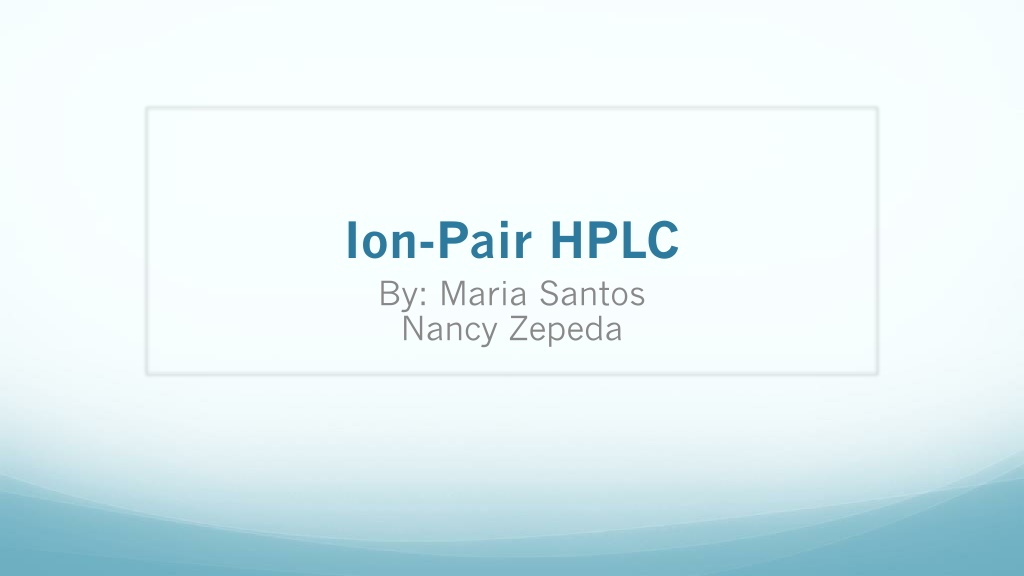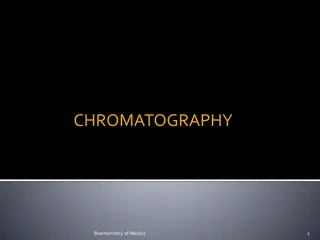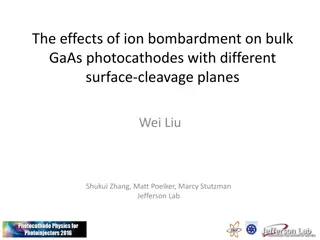Understanding Ion-Pair Chromatography (IPC): Theory and Applications
Ion-Pair Chromatography (IPC) involves adding ionic surfactants to a reversed-phase Chromatography system to affect retention and selectivity of ionic compounds. Developed by Dr. Gordon Schill, IPC is crucial for resolving hydrophilic samples and controlling selectivity in separations. The theory involves the role of ion-pair reagents in enhancing peak shape and retention time, with typical reagents including alkylsulfonates, tetraalkylammonium salts, and strong carboxylic acids. Different retention mechanisms such as partition and adsorption models are employed in IPC for effective separation of analytes.
Download Presentation

Please find below an Image/Link to download the presentation.
The content on the website is provided AS IS for your information and personal use only. It may not be sold, licensed, or shared on other websites without obtaining consent from the author. Download presentation by click this link. If you encounter any issues during the download, it is possible that the publisher has removed the file from their server.
E N D
Presentation Transcript
Ion-Pair HPLC By: Maria Santos Nancy Zepeda
Introduction What is ion-pair chromatography (IPC)? The addition of an ionic surfactant to a reversed-phase Chromatography system (RPC) in order to affect retention and selectivity of ionic compounds. Why do we need Ion-Pair HPLC? When a sample contains ionic components that tend to be very hydrophilic, and so reversed-phase retention can be problematic. When other changes in RPC conditions fail to achieve acceptable resolution.
Background Developed by Dr. Gordon Schill in 1973. Early primary reasons for its used were: To reduced peak tailing for basic solutes. Ability to increase retention of weakly retained ionized acids and bases for acceptable values of K. Provided additional option for the control of selectivity in the separation of ionic samples.
Theory (1) In reversed phase chromatography, ionic compounds are usually not retained by hydrophobic stationary phase. By adding an ion-pair reagent with a ionic end and a hydrophobic tail to the mobile phase, the hydrophobic tail of the reagent gets retained by the stationary phase. Thus an ion exchange group forms on the surface of the stationary phase. (a)Bonded phase (b)Stationary Phase (c)Ion-pair reagent in mobile phase (d)ion-pair reagent adsorbed to Stationary phase (e)Sample ion free in mobile Phase (f)Sample retained on column by ion- pair mechanism. The samples ion exchanges with the counter ion of the ion-pair reagent retained by the stationary phase, thus resulting in greater retention of the sample. [1]
Theory(2) An ion pair reagent is added to enhance peak shape and retention time. The ion pairing agent must be oppositely charged than the analyte and must have good hydrophobicity. Ion-pairing chromatography (IPC) can be used for both positively and negatively charged analytes. Negatively charged reagent can be used to retain positively charged ionic bases. Positively charged reagent can be used to retain negatively charged ionic acids. IPC-Reagent Hydrophilic solute Hydrophobic ion-pair (less retained in RPC) (more retained in RPC) (acids) A- + R+ A-R+ A-, BH+ = ionized acid or base (bases) BH+ + R- BH+R-R+, R- = ion-pairing reagent Stationary phases used for ion-pair are neutral, hydrophobic resins such as polystyrene divinylbenzene (PS-DVB) or bonded silica. [2]
Theory (3) Typical ion pair reagents include: -Alkylsulfonates R-SO3- (R-) Tetraalkylammonium salts R4N+ (R+) Strong carboxylic acids (triflouroacetic acid, TFA; heptaflourobutyric acid, HBA) Chaotropes (BF-, ClO4-, PF6-) [2]
Theory (4) Retention Mechanism: Two possible retention process 1. Partition model 2. Adsorption model Partition Model:. In this model, the ion- pairing agent is present in the mobile phase. The analyte interacts with the ion-pairing agent in the mobile phase first. It forms the ion-pair which is relatively non-polar and partition into the stationary phase and get retained. R+A- (mobilePhase) R+A- (stationary Phase) [2,3]
Theory (5) Adsorption Model: The ion-pairing agent present in the mobile phase gets adsorbed into the non- polar stationary phase due to its lipophilic alkyl chain. As a result, the ion-pairing reagent forms a pseudo ion-exchange layer on the surface of the stationary phase. The analyte interacts with the ion-pairing agent presented on the surface to form ion-pair and gets retained. A- (mobile phase) + R+X- (stationary Phase) A-R+(stationary Phase) + X- [2,3]
Theory(6) Changes in pH For acids, as pH is increase the retention time is increased. For bases, as pH is decrease the retention time is increased. By increasing ionization of the solute, retention is possible due to ion-pairing of the ionized solute. Hydrophilic solute Hydrophobic ion-pair (less retained in RPC) (more retained in RPC) (acids) A- + R+ A-R+ A-, BH+ = ionized acid or base (bases) BH+ + R- BH+R-R+, R- = ion-pairing reagent
Theory (7) Change in concentration and type of Ion Pair-reagent IPC reagent hydrophobicity and retention will increase for an increase in the carbon number of the reagent. The more hydrophobic the IPC reagent, the more strongly it would be retained by the stationary phase. (e.g,. TBA+(16 carbons)is more hydrophobic and more retain than TEA+ (8 carbons). Saturation of column occurs at lower concentration for the more hydrophobic reagents. IPC-reagent preferred concentrations in the mobile phase should not exceed a value that begins to saturate the column because retention then starts to decreased. Due to the increase in the mobile-phase concentration of ion-pair reagent and its counter-ion, thus competing with the ionized sample for ion- exchange retention. [2]
Advantages IPC separation involves two additional variables that can be used for control of selectivity (IPC- reagent type and concentration) . Simple preparation of buffers. Wide choice of carbon chain lengths for improved retention and separation. Significantly reduced separation time (vs. ion exchange). Simultaneous separation of both ionized and non-ionized molecules. High reproducibility of results Improved peak shapes Better separation of large ions (vs. ion exchange) [2]
Disadvantages Greater complexity of operation and more challenging interpretation of results. (e.g., more variables to choose from or to control). Slow column equilibration after changing the mobile phase. Specially slow when IPC reagent is more hydrophobic. Possible that not all of the IPC reagent will be washed from the column. [2]
Applications Biological analysis Ion pair reverse phase chromatography: a versatile platform for the analysis of RNA (2011). Ability to separate large RNA molecules with higher resolution. Quick separations of single and double stranded RNA (less than 10 mins). Manipulation of pair reagent, temperature, and additives to the mobile phase facilitates separation. In addition to efficient isolation and analysis of RNA species, IP RP HPLC provides valuable structural information.
Applications Food Analysis Determination of water-soluble vitamins in infant milk by High-Performance Liquid Chromatography (1997). Separation of molecules with different chemical properties such as stability, polarity, and acidity. Can control pH and concentration of mobile phase. Ability to separate multiple vitamins in a single run. Better resolution in comparison to ion exchange chromatography. Can use multiple detectors (UV is most common). Simpler sample separation with UV than fluorometric detection.
Applications Food analysis Quantification of lactose using ion-pair RP-HPLC during enzymatic lactose hydrolysis of skim milk (2012). Determination of lactose, glucose and galactose in original skim milk. Can analyze lactose content at very low quantities. Simple and quicker preparation compared to GC- no need to chemically convert sugars into volatile and stable derivatives prior to injection. Good recovery rates with fluorescence detector (98-104%). Very accurate- reproducible results Short retention times low limit of quantification (LOQ) and limit of detection (LOD)
Applications Pharmaceutical Analysis Separation and determination of impurities in paracetamol, codeine and pitophenone in the presence of fenpiverinium in combined suppository dosage form (2014). Can determine impurities in dosage form. Sensitive- ability to measure low concentrations of analytes. Great accuracy- highly reproducible results Good limit of detection (LOD) and limit of quantification (LOQ) More robust than RP HPLC-unaffected by changes in pH of buffer and column temperature. Manipulation in pH of buffer leads to better resolved peaks (vs. RP HPLC). Improved peak shape
Conclusion The ion-pairing HPLC is an alternative from RP-HPLC that is particularly useful for increasing the retention capacity of weakly retained compounds. Based on the greater complexity of Ion-pair Chromatography compared to Reverse Phase Chromatography it is recommended that IPC should be considered only after RPC techniques are not effective.
References [1] J.Dolan. LCGC Europe, Volume 21, Issue 5, pp 258-263. [2] L. Snyder, J. Kirkland, and J. Dolan. (2010). Introduction to Modern Liquid Chromatography 3rd Edition. Wiley & sons, Inc., Publications. (pages. 331-347). [3] A. Vailaya, C. Horvath, J Chromatogr. A 829 (1998) 1 27. [4] Dickman, M.J.Chromatography Today, 2011, 22-26. [5] Erich, S.; Anzmann, T.; Fischer, L. J. Food chemistry, 2012, 135, 2393- 2396. [6] Vojta, J.; Hanzl ka, P .; Jedli kaa, A.; Coufal, P . J. Pharmaceutical and Biomedical Analysis, 2014, 102, 85-62.























